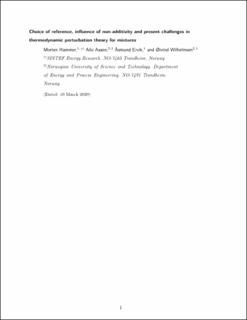| dc.contributor.author | Hammer, Morten | |
| dc.contributor.author | Aasen, Ailo | |
| dc.contributor.author | Ervik, Åsmund | |
| dc.contributor.author | Wilhelmsen, Øivind | |
| dc.date.accessioned | 2020-08-25T07:51:18Z | |
| dc.date.available | 2020-08-25T07:51:18Z | |
| dc.date.created | 2020-03-12T11:37:50Z | |
| dc.date.issued | 2020 | |
| dc.identifier.issn | 0021-9606 | |
| dc.identifier.uri | https://hdl.handle.net/11250/2673786 | |
| dc.description.abstract | This work revisits the fundamentals of thermodynamic perturbation theory for fluid mixtures. The choice of reference and governing assumptions can profoundly influence the accuracy of the perturbation theory. The statistical associating fluid theory for variable range interactions of the generic Mie form equation of state is used as a basis to evaluate three choices of hard-sphere reference fluids: single component, additive mixture, and non-additive mixture. Binary mixtures of Lennard-Jones fluids are investigated, where the ratios of σ (the distance where the potential is zero) and the ratios of ϵ (the well depth) are varied. By comparing with Monte Carlo simulations and results from the literature, we gauge the accuracy of different theories. A perturbation theory with a single-component reference gives inaccurate predictions when the σ-ratio differs significantly from unity but is otherwise applicable. Non-additivity becomes relevant in phase-equilibrium calculations for fluids with high ϵ-ratios or when the mixing rule of σ incorporates non-additivity through an adjustable parameter. This can be handled in three ways: by using a non-additive hard-sphere reference, by incorporating an extra term in the additive hard-sphere reference, or with a single-component reference when the σ-ratio is close to unity. For σ- and ϵ-ratios that differ significantly from unity, the perturbation theories overpredict the phase-equilibrium pressures regardless of reference. This is particularly pronounced in the vicinity of the critical region for mixtures with high ϵ-ratios. By comparing with Monte Carlo simulations where we compute the terms in the perturbation theory directly, we find that the shortcomings of the perturbation theory stem from an inaccurate representation of the second- and third-order perturbation terms, a2 and a3. As mixtures with molecules that differ significantly in size and depths of their interaction potentials are often encountered in industrial and natural applications, further development of the perturbation theory based on these results is an important future work. | en_US |
| dc.language.iso | eng | en_US |
| dc.publisher | AIP Publishing | en_US |
| dc.title | Choice of reference, influence of non-additivity and present challenges in thermodynamic perturbation theory for mixtures | en_US |
| dc.type | Peer reviewed | en_US |
| dc.type | Journal article | en_US |
| dc.description.version | acceptedVersion | en_US |
| dc.source.journal | Journal of Chemical Physics | en_US |
| dc.identifier.doi | 10.1063/1.5142771 | |
| dc.identifier.cristin | 1801312 | |
| dc.description.localcode | This is the authors’ accepted and refereed manuscript to the article. This article may be downloaded for personal use only. Any other use requires prior permission of the author and AIP Publishing. The following article appeared in (citation of published article) and may be found at http://dx.doi.org/10.1063/1.5142771 | en_US |
| cristin.unitcode | 194,64,25,0 | |
| cristin.unitname | Institutt for energi- og prosessteknikk | |
| cristin.ispublished | false | |
| cristin.fulltext | postprint | |
| cristin.qualitycode | 1 | |
